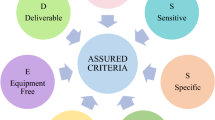Abstract
A low-cost and simple method to enclose the microchannels for paper-based microfluidic devices using highly bio-compatible adhesive seals is proposed in this research. The polyester adhesive seals which originally used for the sealing of 96-Well PCR Plates was used for the sealing of paper-based microfluidic devices. The adhesive seals used to enclose the microchannels in this approach have the advantages of optically clear, strong adhesion to various surfaces without thermal/chemical treatment, free of biomass such as DNA, wide working temperature, highly bio-compatible and low-cost. For the demonstration of the proposed method, a paper-based microfluidic device for amino acids analysis was fabricated using wax printing and then fully enclosed the microchannels with adhesive seals. The bonding strength between adhesive seal and filter paper was also tested in the proposed microchannel enclosing method.





Similar content being viewed by others
References
Carrilho E, Martinez AW, Whitesides GM (2009) Understanding wax printing: a simple micropatterning process for paper-based microfluidics. Anal Chem 81:7091–7095
Cate DM, Adkins JA, Mettakoonpitak J, Henry CS (2015) Recent developments in paper-based microfluidic devices. Anal Chem 87:19–41. doi:10.1021/ac503968p
Choi S, Kim SK, Lee GJ, Park HK (2015) Paper-based 3D microfluidic device for multiple bioassays. Sens Actuators B Chem 219:245–250
Fan Y, Li H, Yi Y, Foulds IG (2014) PMMA to polystyrene bonding for polymer based microfluidic systems. Microsyst Technol 20:59–64
Fenton EM, Mascarenas MR, López GP, Sibbett SS (2009) Multiplex lateral-flow test strips fabricated by two-dimensional shaping. ACS Appl Mater Interfaces 1:124
Garcia PDT, Cardoso TMG, Garcia CD, Carrilho E, Coltro WKT (2014) A handheld stamping process to fabricate microfluidic paper-based analytical devices with chemically modified surface for clinical assays. RSC Adv 4:37637–37644
He Y, Wu WB, Fu JZ (2015) Rapid fabrication of paper-based microfluidic analytical devices with desktop stereolithography 3D printer. RSC Adv 5:2694–2701. doi:10.1039/c4ra12165a
He Y, Gao Q, Wu W-B, Nie J, Fu J-Z (2016) 3D printed paper-based microfluidic analytical devices. Micromachines 7:108. doi:10.3390/mi7070108
Kalish B, Tsutsui H (2014) Patterned adhesive enables construction of nonplanar three-dimensional paper microfluidic circuits. Lab Chip 14:4354–4361. doi:10.1039/c4lc00730a
Koivunen R, Jutila E, Bollström R, Gane P (2016) Hydrophobic patterning of functional porous pigment coatings by inkjet printing. Microfluid Nanofluid 20:83
Kumar A, Hens A, Arun RK, Chatterjee M, Mahato K, Layek K, Chanda N (2015) A paper based microfluidic device for easy detection of uric acid using positively charged gold nanoparticles. Analyst 140:1817–1821
Li Z, Yang J, Zhu L, Tang W (2016) Fabrication of paper micro-devices with wax jetting. RSC Adv 6:17921–17928. doi:10.1039/c5ra26255k
Liu M, Zhang C, Liu F (2015) Understanding wax screen-printing: a novel patterning process for microfluidic cloth-based analytical devices. Anal Chim Acta 891:234–246. doi:10.1016/j.aca.2015.06.034
Martinez AW, Phillips ST, Wiley BJ, Gupta M, Whitesides GM (2008) FLASH: a rapid method for prototyping paper-based microfluidic devices. Lab Chip 8:2146
Mentele MM, Cunningham J, Koehler K, Volckens J, Henry CS (2012) Microfluidic paper-based analytical device for particulate metals. Anal Chem 84:4474
Montgomery RH, Hollins BC (2016) Fabrication method for paper microfluidics utilizing 3D printing and PDMS stamps. In: Biomedical engineering conference. doi:10.1109/sbec.2016.70
Nie Z et al (2010) Electrochemical sensing in paper-based microfluidic devices. Lab chip 10:477
O’Malley JJ, Ulmer RW (1973) Thermal stability of glucose oxidase and its admixtures with synthetic polymers. Biotechnol Bioeng 15:917–925
Renault C, Koehne J, Ricco AJ, Crooks RM (2014) Three-dimensional wax patterning of paper fluidic devices. Langmuir ACS J Surf Coll 30:7030–7036
Rosenfeld T, Bercovici M (2014) 1000-fold sample focusing on paper-based microfluidic devices. Lab Chip 14:4465–4474. doi:10.1039/c4lc00734d
Salentijn GI, Hamidon NN, Verpoorte E (2016) Solvent-dependent on/off valving using selectively permeable barriers in paper microfluidics. Lab Chip 16:1013–1021
San Park T, Baynes C, Cho S-I, Yoon J-Y (2014) Paper microfluidics for red wine tasting. RSC Adv 4:24356. doi:10.1039/c4ra01471e
Schilling KM, Lepore AL, Kurian JA, Martinez AW (2012) Fully enclosed microfluidic paper-based analytical devices. Anal Chem 84:1579–1585. doi:10.1021/ac202837s
Sechi D, Greer B, Johnson J, Hashemi N (2013) Three-dimensional paper-based microfluidic device for assays of protein and glucose in urine. Anal Chem 85:10733–10737
Suzuki Y, Yamada M, Seki M (2010) Sol–gel based fabrication of hybrid microfluidic devices composed of PDMS and thermoplastic substrates. Sens Actuators B Chem 148:323–329
Wang J, Monton MR, Zhang X, Filipe CD, Pelton R, Brennan JD (2014) Hydrophobic sol-gel channel patterning strategies for paper-based microfluidics. Lab Chip 14:691
Xie Y-C, Xu Y, Yung K-L, Huang L-B, Lee M-H (2010) Photolamination bonding for PMMA microfluidic chips. Microsyst Technol 16:1887–1891. doi:10.1007/s00542-010-1117-6
Yu L, Shi ZZ (2015) Microfluidic paper-based analytical devices fabricated by low-cost photolithography and embossing of Parafilm®. Lab Chip 15:1642–1645. doi:10.1039/C5LC00044K
Yu J, Ge L, Huang J, Wang S, Ge S (2011) Microfluidic paper-based chemiluminescence biosensor for simultaneous determination of glucose and uric acid. Lab Chip 11:1286
Zhang Y, Zuo P, Ye BC (2015) A low-cost and simple paper-based microfluidic device for simultaneous multiplex determination of different types of chemical contaminants in food. Biosens Bioelectron 68:14–19. doi:10.1016/j.bios.2014.12.042
Zhu WJ, Feng DQ, Chen M, Chen ZD, Zhu R, Fang HL, Wang W (2014) Bienzyme colorimetric detection of glucose with self-calibration based on tree-shaped paper strip. Sens Actuators B Chem 190:414–418
Acknowledgements
This work was supported by the Fundamental Research Funds for the Central Universities (ZY1613, buctrc201609).
Author information
Authors and Affiliations
Corresponding author
Rights and permissions
About this article
Cite this article
Fan, Y., Liu, S., Gao, K. et al. Fully enclosed paper-based microfluidic devices using bio-compatible adhesive seals. Microsyst Technol 24, 1783–1787 (2018). https://doi.org/10.1007/s00542-017-3528-0
Received:
Accepted:
Published:
Issue Date:
DOI: https://doi.org/10.1007/s00542-017-3528-0




